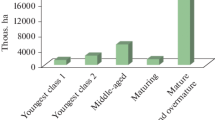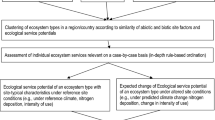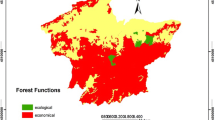Abstract
This article gives an assessment of the international criteria for the sustainable management of forests on the basis of indicators according to the International Cooperative Programme on Assessment and Monitoring of Air Pollution Effects on Forests (ICP Forests). The given program allows us to assess Criterion 2: Maintenance of Forest Health and Vitality and Criterion 4: Conservation and Improvement of the Biological Diversity of the Forest Ecosystem. The informative indicators of Criterion 2 are the degrees of the tree crown defoliation and the composition parameters of atmospheric deposition, soils, and dominant tree plant photosynthetic organs. The assessment of Criterion 4 is carried out on the basis of biodiversity items, including forest distribution by age and species composition, sets of forest community major groups (groups of forest types) and their quantitative representation in the area, number of tree and shrub species found in the forests, and species richness and species saturation. An attempt has been made to show whether the network of the permanent observation posts reflects in full measure the forest typological and age structure in Karelia and Karelian Isthmus.
Similar content being viewed by others
References
Alekseev, A.S., Grigor’eva, O.S., Egorova, G.L., and Treifel’d, R.F., Otsenka rastitel’nogo raznoobraziya lesnykh ekosistem (na primere Karel’skogo peresheika Leningradskoi oblasti) (Assessment of the Plant Diversity in Forest Ecosystems of Karelian Isthmus, Leningrad Oblast), St. Petersburg, 2002.
Bakhmet, O.N., Fedonets, N.G., and Kryshen’, A.M., Studies conducted within the International Program ICP-Forests in Karelia, Tr. Karel. Nauchn. Tsentr, Ross. Akad. Nauk, 2011, no. 2, pp. 133–139.
Geobotanicheskoe raionirovanie Naechernozem’ya evropeiskoi chasti RSFSR (Geobotanical Zoning of Nechernozem Region of European Part of RSFSR), Aleksandrova, V.D. and Yurkovskaya, T.K., Eds., Leningrad: Nauka, 1989.
Gosudarstvennyi doklad o sostoyanii okruzhayushchei sredy Respubliki Kareliya v 2011 godu (State Report on Environmental Conditions of Karelia Republic in 2011), Gromtsev, A.N., Ed., Petrozavodsk: Andreev P.N., 2012.
Gromtsev, A.N., Landshaftnaya ekologiya taezhnykh lesov: teoreticheskie i prikladnye aspekty (Theoretical and Applied Aspects of Landscape Ecology of Taiga), Petrozavodsk: Karel. Nauchn. Tsentr, Ross. Akad. Nauk, 2000.
Gromtsev, A.N., Osnovy landshaftnoi ekologii evropeiskikh taezhnykh lesov Rossii (Principles of Landscape Ecology of European Taiga of Russia), Petrozavodsk: Karel. Nauchn. Tsentr, Ross. Akad. Nauk, 2008.
Gromtsev, A.N., Principles of landscape ecology of European taiga of Russia, Mater. nauchno-prakt. konf. “Sovremennoe sostoyanie i perspektivy razvitiya seti osobo okhranyaemykh territorii evropeiskogo Severa i Urala (Proc. Sci.-Pract. Conf. “Current Conditions and Prospective Development of the Net of Strictly Protected Territories of European North and Ural), Syktyvkar, 2010, pp. 20–22.
Zapovednaya priroda Karel’skogo peresheika (Nature Reserves of Karelian Isthmus), Noskov, G.A., Ed., St. Petersburg: Professional, 2004.
Koptsik, S.V., Koptsik, G.N., and Alyabina, I.O., Assessment of the risk of excess sulfur input into terrestrial ecosystems of the Kola Peninsula, Russ. J. Ecol., 2008, vol. 39, no. 5, pp. 327–336.
Kulikov, V.S., Where is the southeastern border of Fennoscandia? Dokl. Akad. Nauk, 1997, vol. 356, no. 4, pp. 545–547.
Lukina, N.V. and Nikonov, V.V., Biogeokhimicheskie tsikly v lesakh severa v uloviyakh aerotekhnogennogo zagryazneniya (Biogeochemical Cycles in the Northern Forests Affected by Industrial Air pollution Pollution), 2 vols. Apatity: Karel. Nauchn. Tsentr, Ross. Akad. Nauk, 1996.
Lukina, N.V. and Nikonov, V.V., Pitatel’nyi rezhim lesov severnoi taigi: prirodnye i tekhnogennye aspekty (Nutrition Regime of the Forests of Northern Taiga: Natural and Technogeneous Aspects), Apatity: Karel. Nauchn. Tsentr, Ross. Akad. Nauk, 1998.
Lukina, N.V., Nikonov, V.V., and Kalatskaya, M.N., Chemical composition of the spruce needles on the Kola Peninsula, Lesovedenie, 2000, no. 3, pp. 55–64.
Lukina, N.V., Polyanskaya, L.M., and Orlova, M.A., Pitatel’nyi rezhim pochv severotaezhnykh lesov (Nutrition Regime of North Taiga Soils), Moscow: Nauka, 2008.
Lukina, N.V., Sukhareva, T.A., and Isaeva, L.G., Tekhnogennye digressii i vosstanovitel’nye suktsessii v severotaezhnykh lesakh (Technogeneous Digressions and Recovery Successions in North Taiga Forests), Moscow: Nauka, 2005.
Metodicheskie rekomendatsii po monitoringu lesov v sootvetstvii s mezhdunarodnoi programmoi ICP Forests, utvezhdennye prikazom Rosleskhoza ot 15.07.2009, no. 292 (Methodological Recommendations for Monitoring of Forests According to International Program ICP Forests Approved by Order no. 292 of Russian Ministry of Agriculture on July 5, 2009).
Morozova, R.M. and Fedorets, N.G., Zemel’nye resursy Karelii i ikh okhrana (Terrestrial Resources of Karelia and Their Protection), Petrozavodsk: Karel. Nauchn. Tsentr, Ross. Akad. Nauk, 2004.
Nikonov, V.V. and Lukina, N.V., Time-spatial variability of nutrition regime of Al-Fe-humic podzolic soil of boreal forests, Pochvovedenie, 2000, no. 12, pp. 1309–1316.
Orlova, M.A., Soil fertility formation as a ecosystem function of forests, in Raznoobrazie i dinamika lesnykh ekosistem Rossii (Diversity and Dynamics of Forest Ecosystems of Russia), Isaev, A.S., Ed., (in press).
Otchet Tsentra po problemam ekologii i produktivnosti lesov o nauchno-issledovatel’skoi rabote po teme “Razrabotka nauchno-obosnovannykh predlozhenii po kategoriyam i indikatoram oslableniya lesov na osnove rezul’tatov lesopatologicheskogo monitoringa, vypolnennogo po mezhdunarodnym standartam, dlya otsenki ispolneniya peredannykh polnomochii v oblasti lesnykh otnoshenii” (A Report of Center of Ecological Problems and Forest Productivity on Scientific-Research Work on “Development of Scientifically Substantiated Recommendations on Criteria and Indicators of Forest Weakening Based on Forest-Pathological Monitoring Performed According to International Standards for Assessment of Passed Authorities in the Field of Forest Management”), Moscow, 2011, parts 1–2.
Otchet Tsentra po problemam ekologii i produktivnosti lesov o nauchno-issledovatel’skoi rabote po teme “Razrabotka nauchno-obosnovannykh predlozhenii po kategoriyam i indikatoram oslableniya lesov na osnove rezul’tatov lesopatologicheskogo monitoringa, vypolnennogo po mezhdunarodnym standartam, dlya otsenki ispolneniya peredannykh polnomochii v oblasti lesnykh otnoshenii” (A Report of Center of Ecological Problems and Forest Productivity on Scientific-Research Work on “Development of Scientifically Substantiated Recommendations on Criteria and Indicators of Forest Weakening Based on Forest-Pathological Monitoring Performed According to International Standards for Assessment of Passed Authorities in the Field of Forest Management”), Moscow, 2012, parts 3–4.
Polozhenie o lesnom monitoringe. Federal’naya sluzhba lesnogo khozyaistva Rossii. Pil’mo ot 29.11.1995 goda, no. MG-1-17-6/287 (Regulation on Forest Monitoring of Federal Service of Forest Economy of Russia, Letter of 29.11. 1995, no. MG-1-17-6/287).
Raznoobrazie bioty Karelii: usloviya formirovaniya, soobshchestva, vidy (Diversity of Karelian Biota: Conditions, Communities, and Species), Petrozavodsk: Karel. Nauchn. Tsentr, Ross. Akad. Nauk, 2003.
Rozhnova, T.A., Pochvennyi pokrov Karel’skogo peresheika (Soil Cover of Karelian Isthmus), Moscow, 1963.
Yurkovskaya, T.K. and Elina, G.A., Vosstanovlennaya rastitel’nost’ Karelii na geobotanicheskoi i paleokartakh (Recovered Vegetation of Karelia on Geobotanical and Palaeological Maps), Petrozavodsk: Karel. Nauchn. Tsentr, Ross. Akad. Nauk, 2009.
Criteria and Indicators for the Conservation and Sustainable Management of Temperate and Boreal Forests. The Montreal Process, 2009, 4th ed.
Rigina, O., Introduction into the environmental problems in the Kola Peninsula, in Detection of pollution-induced forest decline in the Kola Peninsula using remote sensing and mathematical modeling. Licentiate Thesis. Swedish University of Agricultural Sciences. Raport/report 9. 1998, pp. 8–34.
Singh, S.S. and Brydon, J.E., Activity of aluminium hydroxyl sulfates and the stability of hydroxyaluminium interlayers in montmorillonite, Can. J. Soil Sci., 1970, vol. 50, pp. 219–225.
State of Europe’s Forests Status and Trends in Sustainable Forest management in Europe, United Nations, UNECE, FAO, 2011.
Author information
Authors and Affiliations
Corresponding author
Additional information
Original Russian Text © N.V. Lukina, M.A. Orlova, A.V. Gornov, A.M. Kryshen’, P.V. Kuznetsov, S.V. Knyazeva, V.E. Smirnov, O.N. Bakhmet, S.P. Eydlina, V.V. Ershov, N.V. Zukert, L.G. Isaeva, 2013, published in Lesovedenie, 2013, No. 5, pp. 62–75.
Rights and permissions
About this article
Cite this article
Lukina, N.V., Orlova, M.A., Gornov, A.V. et al. Assessment of sustainable forest management criteria using indicators of the international programme ICP forests. Contemp. Probl. Ecol. 6, 734–745 (2013). https://doi.org/10.1134/S1995425513070081
Received:
Published:
Issue Date:
DOI: https://doi.org/10.1134/S1995425513070081




